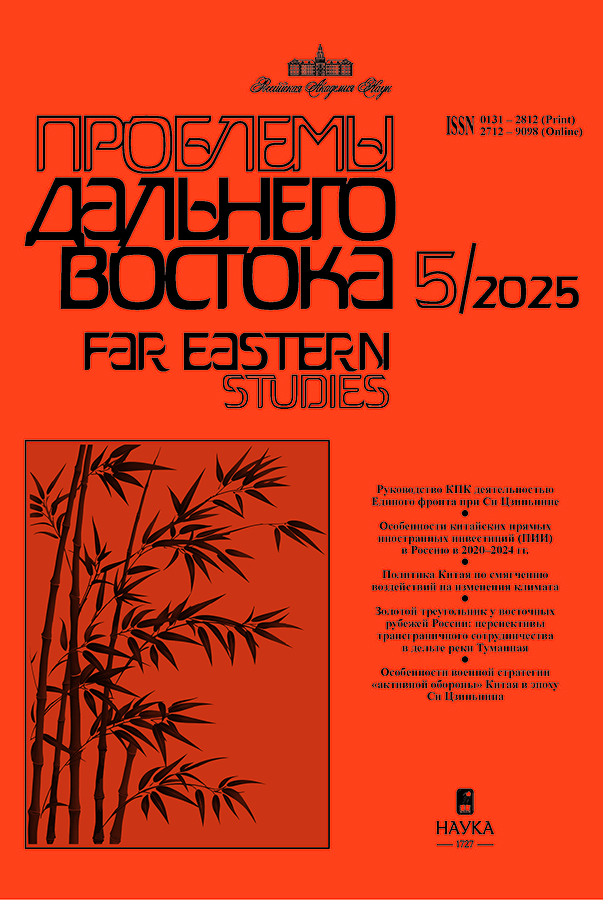From the Factory of the World to a Technological Leader: China's Role in the Semiconductor Industry
- Авторлар: Vremya E.G1
-
Мекемелер:
- E.M. Primakov National Research Institute of World Economy and International Relations of the Russian Academy of Sciences
- Шығарылым: № 5 (2025)
- Беттер: 76-89
- Бөлім: Economics
- URL: https://journals.eco-vector.com/0131-2812/article/view/696489
- DOI: https://doi.org/10.31857/S0131281225050051
- ID: 696489
Дәйексөз келтіру
Аннотация
The article is devoted to the transformation of China's role in the global semiconductor industry from the largest assembly center to a contender for global technological leadership. China, which has long dominated predominantly the low-tech stages of the global value chain, made unprecedented efforts between 2010–2025 to reduce the technological gap and reduce dependence on foreign chip manufacturers. The research was conducted on the basis of the concepts of technological leadership, technological sovereignty and industrial policy, as well as the theory of global value chains. The purpose of this study is to analyze China's role in the global semiconductor industry from the position of the largest manufacturing hub to a potential technological leader, evaluate the results of government policy, key achievements of Chinese companies, and identify the country's existing problems and prospects in the context of global technological competition. The paper examines government initiatives and programs, including large-scale strategies "Made in China 2025" and the National Fund for Investment in the Integrated Circuit Industry, aimed at developing its own innovation base and increasing the localization of semiconductor production. Special attention is paid to assessing the current state of the industry, analyzing the achievements of Chinese companies, as well as problems related to US sanctions, restrictions on access to key technologies, lithography equipment, and qualified personnel. It is concluded that, despite significant successes and large-scale government support, China has not yet achieved full technological autonomy. Geopolitical barriers and the continuing technological lag behind industry leaders remain significant obstacles to achieving this goal. However, the potential of the market, the constant growth of domestic demand, the level of investment and the strategic determination of China allow us to predict its further strengthening of its position in the global industry.
Авторлар туралы
E. Vremya
E.M. Primakov National Research Institute of World Economy and International Relations of the Russian Academy of Sciences
Email: ekaterina.vremya@yandex.ru
ORCID iD: 0009–0008–9771–1429
Moscow, Russia
Әдебиет тізімі
- Chzhan S. Rol' chelovecheskogo potenciala v razvitii innovacionnogo potenciala na primere opyta Kitajskoj Narodnoj Respubliki [The role of human potential in the development of innovative potential on the example of the experience of The People's Republic of China]. Ekonomika: vchera, segodnya, zavtra. 2024. T. 14. No. 4A. S. 256–269. (In Russ.)
- Danilin I. Amerikano-kitajskaya tekhnologicheskaya vojna cherez prizmu tekhnonacionalizma [The U.S.- China technological war through the prism of techno-nationalism]. IMEMO RAN. 2021. No. 1 (60). S. 29–43. (In Russ.)
- Golubeva A.S. Kitaj v usloviyah trinadcatoj pyatiletki: itogi i perspektivy [China in the thirteenth fiveyear plan: results and prospects]. Innovacii i investicii. 2021. No. 10. S. 24–31. (In Russ.)
- He A. China’s techno-industrial development: A case study of the semiconductor industry. CIGI papers. 2021. No. 252
- Kostin K. B., Malevich Yu. V., Karimova L.A. Evolyuciya, ocenka sovremennogo sostoyaniya i rol' poluprovodnikovoj promyshlennosti v mirovoj ekonomike [The evolution, current status and role of the semiconductor industry in the global economy]. Journal of Economics, Entrepreneurship and Law. 2025. T. 15. No. 1. S. 499–522. (In Russ.)
- Levchenko T.A. Ekonomicheskoe razvitie Kitaya: osnovnye tendencii i celi 14-j pyatiletki [Сhina’s economic development: main trends and objectives of 14th five-year plan]. Vestnik AGTU. Seriya: Ekonomika. 2022. No. 4. S. 109–116. (In Russ.)
- Ostrovskij A.V., Afonas'eva A.V., Kamennov P.B. Perspektivy razvitiya nauki, tekhniki i innovacij v KNR [Prospects for the development of science, technology and innovation in the PRC]. Vostochnaya Aziya: fakty i analitika. 2019. No. 2. S. 6–28. (In Russ.)
- Reshetnikova M. S., Lukina Yu. D. Politika Kitaya v bor'be za mirovoe liderstvo v oblasti iskusstvennogo intellekta [China's policy in the race for global leadership in artificial intelligence]. Voprosy innovacionnoj ekonomiki. 2020. T. 10. No. 4. S. 1929–1942. (In Russ.)
- Safronova E.I. Redkozemel'nyye elementy i geopoliticheskoye znacheniye BRIKS [Rare Earth Elements and the Geopolitical Importance of BRICS]. Problemi dal’nego vostoka. 2024. No. 6. S. 74–90. doi: 10.31857/S0131281224060058/
- Smorodinskaya N.V., Katukov D.D. Kurs na tekhnologicheskij suverenitet: novyj global'nyj trend i rossijskaya specifika [Moving towards technological sovereignty: a new global trend and the russian specifics]. Baltijskij region. 2024. No. 3. S. 108–135. doi: 10.5922/2079–8555–2024–3–6. (In Russ.)
- Syuj Ch., Troshin A.S. Innovacionnyj variant razvitiya ekonomiki Kitaya [An innovative option for the development of China's economy]. Innovacii i investicii. 2021. No. 3. S. 31–35. (In Russ.)
- Volgina N.A., Lyu P. Kitaj v global'nyh cepochkah stoimosti: nekotorye fakty [China in the Global Value Chains: Some Facts]. Vestnik TGEU. 2020. No. 4 (96). S. 20–27. (In Russ.)
- Yuj H. Vozdejstvie ekonomicheskih sankcij i tekhnologicheskoj blokady na nacional'nuyu innovacionnuyu sistemu Kitaya [The impact of economic sanctions and technology embargoes on China’s national innovation system]. Ekonomika i biznes: teoriya i praktika. 2025. No. 3 (121). S. 392–396. doi: 10.24412/2411–0450–2025–3–392–396. (In Russ.)
Қосымша файлдар









